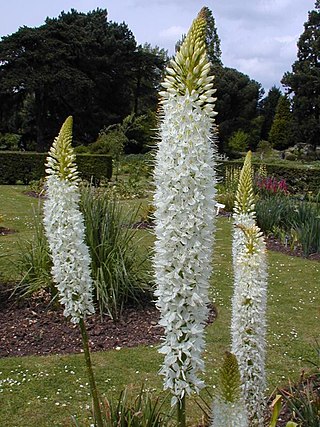
The urial, also known as arkars, shapo, or shapu, is a wild sheep native to Central and South Asia. It is listed as Vulnerable on the IUCN Red List.

Gagea is a large genus of spring flowers in the lily family. It is found primarily in Eurasia with a few species extending into North Africa and one species in North America.

Lagochilus is a genus of the mint family that contains Turkistan mint.
The comb-toed jerboa is a species of rodent in the family Dipodidae. It is monotypic within the genus Paradipus. It is found in Kazakhstan, Turkmenistan, and Uzbekistan.

Eremurus is a genus of deciduous perennial flowers in the family Asphodelaceae. They are also known as the foxtail lilies or desert candles. They are native to eastern Europe in, and temperate Asia from Turkey to China, with many species in Central Asia.

Hemipenthes is a large genus of flies belonging to the family Bombyliidae (bee-flies). There are many described species, distributed throughout the Holarctic realm. These are small to large robust flies with a body length of 5–14 mm. They can be distinguished from similar genera (Villa) by their wing venation. A number of species formerly in this genus were moved to a separate genus, ins in 2020.

Amberboa is a genus of flowering plants in the family Asteraceae, described as a genus in 1832.

Epilasia is a genus of flowering plants in the family Asteraceae.

Galeodes is a genus of solifuges or sun spiders. The nearly 200 species in this genus are found in northern Africa, southeastern Europe and Asia. Like other solifuges, they are mainly nocturnal and found in arid habitats. They often have long hairy appendages and are not as stout bodied or dark and contrastingly coloured as some other solifuges. Some Galeodes species are able to produce sounds by stridulation. These are usually raspy or hiss-like and may be imitations of the sounds of vipers, to serve a defensive function. As in other solifuges, mating involves the male depositing a spermatogonia that is manipulated into the female genital opening using their chelicera. The male strokes the female using the palps allowing her to be approached. Females will often feed on males before or after mating. The female then deposits the eggs in a burrow in soil and in some species guards them.
Merizomena is a genus in the beetle family Carabidae. There are about 13 described species in Merizomena.
Eremosphodrus is a genus of ground beetles in the family Carabidae. There are at least two described species in Eremosphodrus.
Pseudotaphoxenus is a genus of ground beetles in the family Carabidae. There are more than 110 described species in Pseudotaphoxenus, found in temperate Asia.
Stenolepta is a genus of ground beetles in the family Carabidae. There are at least three described species in Stenolepta.
Bedeliolus is a genus of ground beetles in the family Carabidae. There are at least three described species in Bedeliolus.

Ungernia is a genus of bulb-forming plants in the Amaryllis family, native to central and south-central Asia Asia.

Zaitunia is a genus of crevice weavers that was first described by Pekka T. Lehtinen in 1967.
Coptosia elyandti is a species of beetle in the family Cerambycidae. It was described by Semenov-Tian-Shanskij in 1891. It is known from Turkmenistan, Kyrgyzstan, Tajikistan, Kazakhstan, and Uzbekistan.

The taxonomy of Tulipa places the genus in the family Liliaceae, and subdivides it as four subgenera, and comprises about 75 species.
Aphilenia is a genus of leaf beetles in the subfamily Eumolpinae. It is distributed in Central and East Asia as well as southern Russia. Members of the genus are adapted to dry climates, and feed on bushes of the genus Calligonum. In 2012, the genus was moved from the tribe Bromiini to the tribe Nodinini.

Pseudomogrus is a genus of jumping spiders first described by Eugène Simon in 1937.











